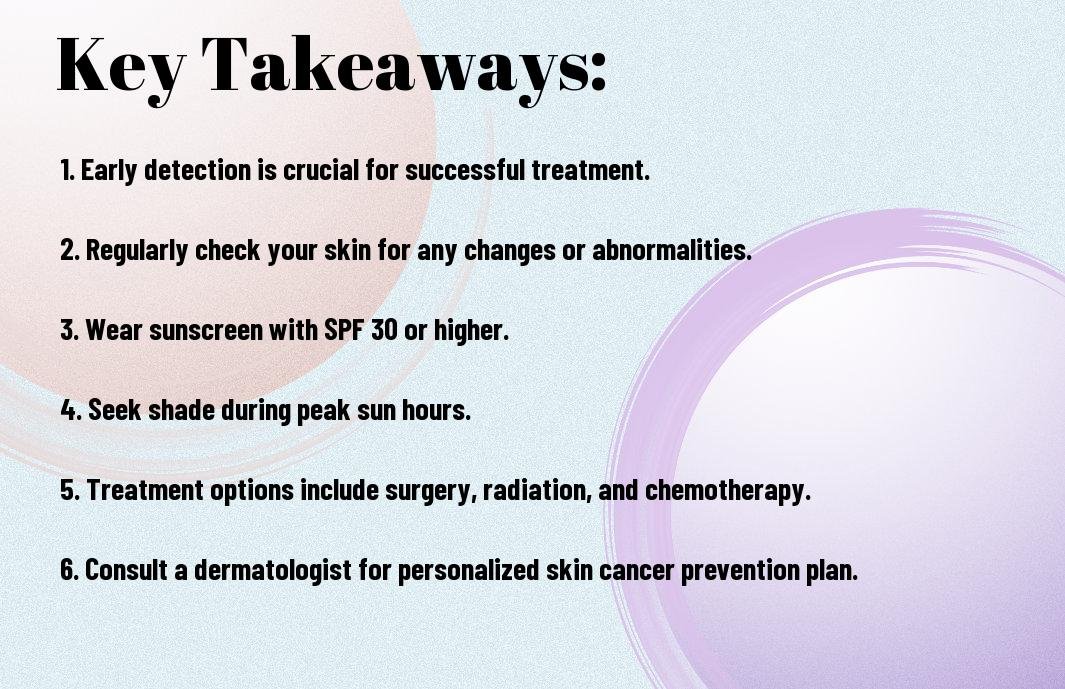Enlighten yourself about the menacing threat of skin cancer with this comprehensive guide. Skin cancer is the most common type of cancer in the world, but with early detection and proper prevention measures, it can be successfully tackled. In this article, we will delve into the crucial early signs to look out for, essential prevention strategies, and the effective treatment options available.
Key Takeaways:
- Early detection is crucial: Knowing the early signs of skin cancer, such as changes in moles or new growths, can lead to early treatment and significantly improve chances of successful outcomes.
- Sun protection is vital: Regular use of sunscreen, wearing protective clothing, and seeking shade can greatly reduce the risk of developing skin cancer.
- Treatment options are available: From surgery and radiation therapy to immunotherapy and targeted therapy, there are various treatment options for skin cancer, depending on the type and stage of the disease.

Understanding Skin Cancer
The incidence of skin cancer has been on the rise, making it crucial for individuals to understand the disease, its early signs, prevention, and treatment options. With a better understanding of skin cancer, individuals can take proactive steps to protect themselves and seek prompt medical attention when necessary.
Types of Skin Cancer
There are three main types of skin cancer: basal cell carcinoma, squamous cell carcinoma, and melanoma. Basal cell carcinoma is the most common form of skin cancer, typically appearing as a flesh-colored, pearl-like bump or a pinkish patch of skin. Squamous cell carcinoma, on the other hand, often looks like a firm, red nodule or a flat lesion with a scaly crust. Melanoma, the most dangerous form of skin cancer, can develop from existing moles or appear as a new, dark spot on the skin. After diagnosis, treatment options for skin cancer may include excisional surgery, curettage and electrodesiccation, mohs surgery, radiation therapy, and immunotherapy.
Causes and Risk Factors
With chronic exposure to ultraviolet (UV) radiation from the sun or tanning beds, the risk of developing skin cancer increases significantly. Other risk factors for skin cancer include a history of sunburns, a weakened immune system, exposure to environmental toxins, and a family history of skin cancer. Recognizing the risk factors and taking preventive measures such as applying sunscreen with a high SPF, wearing protective clothing, and seeking shade can reduce the risk of developing skin cancer.
Recognizing the importance of early detection and prompt treatment is crucial in reducing the impact of skin cancer. Squamous and basal cell carcinomas are highly treatable when detected early, making regular skin examinations and self-monitoring of moles and skin lesions essential. Early intervention can lead to successful treatment outcomes and improved prognosis for individuals affected by this widespread and potentially life-threatening disease.

Early Signs and Symptoms
After understanding the importance of regular skin checks and being proactive about skin cancer prevention, it is crucial to recognize the early signs and symptoms of skin cancer. Early detection is key to successful treatment and increased chances of recovery.
Recognizing Basal Cell Carcinoma
The most common type of skin cancer, basal cell carcinoma, often appears as a painless, shiny bump on the skin, especially on the face, ears, or neck. It may also manifest as a scaly patch or a scar-like lesion that is pale in color.
The lesions caused by basal cell carcinoma can bleed easily and do not heal, or they may develop into an open sore that does not seem to go away. It is important to be aware of any abnormal changes in the skin and seek medical advice if any irregularities are noticed.
Identifying Squamous Cell Carcinoma
Any firm, red nodule or a flat lesion with a scaly and crusty surface could be a sign of squamous cell carcinoma. These lesions usually appear on sun-exposed areas of the skin such as the face, ears, neck, and back of hands.
Carcinoma may also present as a persistent, non-healing sore or a raised growth with a central depression. These signs should not be ignored, and immediate medical attention is essential for early diagnosis and treatment.
To accurately identify squamous cell carcinoma, pay attention to any changes in existing skin growths, and consult a dermatologist if any unusual symptoms are observed. Early intervention is crucial in managing and treating this type of skin cancer.
Detecting Melanoma
With melanoma, it is important to be mindful of the ABCDEs of skin changes – Asymmetry, Border irregularity, Color variation, Diameter larger than a pencil eraser, and Evolving size, shape, or color of the mole.
To stay vigilant, monitor any moles or pigmented spots on the skin for any changes, and seek medical advice immediately if there are any concerns about melanoma. Early detection and prompt treatment significantly improve the prognosis for individuals with melanoma.
When to Seek Medical Advice
Detecting any concerning changes in the skin that persist for more than a few weeks, such as new growths, sores that do not heal, or changes in existing moles, should prompt a visit to a healthcare professional for a thorough examination.
Signs of skin cancer such as unexplained bleeding, itching, tenderness, or pain should not be dismissed and warrant immediate attention from a dermatologist or healthcare provider. Early intervention can make a significant difference in the outcome of skin cancer treatment.

Prevention Strategies
Unlike treatment options, prevention strategies for skin cancer focus on minimizing exposure to harmful ultraviolet (UV) radiation and reducing risk factors that contribute to the development of the disease.
Sun Protection
Any outdoor activity that exposes the skin to sunlight carries the risk of UV radiation exposure. Applying sunscreen with a high SPF is crucial to minimizing this risk. Additionally, wearing protective clothing such as wide-brimmed hats, long-sleeved shirts, and sunglasses can provide additional protection against harmful UV rays.
Regular application of sunscreen, particularly during peak sun hours, is vital for maintaining skin health. It is important to reapply sunscreen every two hours or more frequently if swimming or perspiring heavily. Avoiding direct sunlight during peak hours (10am-4pm) when UV radiation is at its highest can significantly reduce the risk of skin damage and skin cancer development.
Regular Skin Examinations
Protective measures such as regular self-examinations and professional skin checks play a critical role in early detection of skin cancer. Performing monthly self-examinations of the skin and closely monitoring any changes in moles, freckles, or unusual skin growths can aid in the early identification of potential skin cancer. Seeking professional skin checks annually or as recommended by a dermatologist can provide additional reassurance and early detection opportunities.
Plus, individuals with a history of excessive sun exposure, fair skin, or a family history of skin cancer should be particularly vigilant in conducting regular skin examinations and seeking professional medical advice when any concerning changes are observed.
Risk Factor Reduction
Any lifestyle choices that contribute to an increased risk of skin cancer should be addressed to reduce the overall likelihood of developing the disease. The most effective way to reduce risk factors is by avoiding prolonged sun exposure and utilizing protective measures outdoors, including sunscreen, protective clothing, and seeking shade when possible.
Usage of indoor tanning devices should be avoided completely to minimize the risk of UV radiation exposure, as these devices have been strongly linked to an increased risk of skin cancer. Additionally, individuals should adhere to safe sun practices and avoid habitual sunburns, as repeated sunburns can significantly elevate the risk of skin cancer.
Diagnostic Approaches
Now, when it comes to diagnosing skin cancer, early detection is key. If you notice any changes in your skin, it is important to seek medical attention right away. A dermatologist can perform various diagnostic tests to determine if you have skin cancer. For more information on diagnosis and treatment, you can visit Skin cancer – Diagnosis and treatment.
Skin Examination and History
On initial consultation, the dermatologist will conduct a thorough examination of the skin, paying close attention to any moles, lesions, or abnormal areas. It is important to provide a detailed medical history, including any family history of skin cancer or significant sun exposure. This information helps the dermatologist assess the risk factors and determine the appropriate course of action.
During the skin examination, the dermatologist will look for any abnormal changes in color, size, shape, or texture of moles or lesions. They will also examine the surrounding skin for any signs of irregularities. This initial assessment is crucial in identifying any potential signs of skin cancer.
Biopsy Techniques
To confirm a diagnosis of skin cancer, a biopsy is often performed. With this procedure, a small sample of the suspicious skin tissue is removed and examined under a microscope. There are different biopsy techniques, including shave biopsy, punch biopsy, and excisional biopsy. The choice of technique depends on the size and location of the lesion.
A punch biopsy is commonly used for suspicious moles or lesions. It involves using a special tool to remove a cylindrical tissue sample for analysis. This technique allows the dermatologist to obtain a deeper sample, which is important for accurately diagnosing skin cancer. The biopsy results will determine the type and stage of the skin cancer, guiding the treatment plan.
Now, understanding skin cancer and its diagnostic approaches is crucial in ensuring early detection and timely intervention. Whether it’s through a comprehensive skin examination, biopsy techniques, or precise staging, accurate diagnosis is pivotal in determining the appropriate treatment and improving patient outcomes.
Treatment Options
To effectively address skin cancer, there are several treatment options available. The choice of treatment depends on the type and stage of skin cancer, as well as the patient’s overall health. It is vital to consult with a healthcare professional to determine the best approach for each individual case.
Surgical Methods
Treatment through surgical methods is commonly used for removing cancerous growths. Depending on the size and location of the tumor, different surgical techniques may be employed, including excision, Mohs surgery, and lymph node dissection. These procedures aim to completely remove cancerous cells while preserving healthy tissue as much as possible, ensuring the best possible outcome for the patient.
Radiation Therapy
Therapy involving radiation is often recommended for skin cancer cases where surgery is not feasible, or when cancer cells remain after surgery. Radiation therapy utilizes high-energy x-rays or other forms of radiation to destroy cancer cells and prevent their growth. This targeted approach minimizes damage to surrounding healthy tissue and is commonly used in conjunction with surgery or as a primary treatment for certain types of skin cancer.
Options for radiation therapy include external beam radiation and brachytherapy, both of which have demonstrated positive outcomes in controlling and eradicating skin cancer cells.
Chemotherapy
One of the more recognized cancer treatments, chemotherapy involves the use of powerful medications to eradicate cancer cells. While it is not as commonly used for skin cancer as for other types of cancer, in specific cases where cancer has spread to other parts of the body, chemotherapy may be recommended. The medications can be administered orally or intravenously, targeting cancer cells throughout the body to halt their growth and spread.
A combination of chemotherapy drugs may be used, and the treatment plan is tailored to the individual’s needs and the type of skin cancer being addressed. It is important to note that chemotherapy may have side effects, so close monitoring by healthcare professionals is essential.
Targeted Therapy and Immunotherapy
Therapy using targeted drugs and immunotherapy focuses on utilizing specific medications that target cancer cells’ unique features or support the body’s immune system in fighting cancer. These advanced treatments offer promising results, especially in cases where traditional treatments may be less effective. Surgical removal of lymph nodes, if necessary, is often associated with these treatments to prevent the spread of cancer.
Photodynamic Therapy
Targeted for certain types of skin cancer, photodynamic therapy involves the application of a photosensitizing agent to the skin, followed by exposure to a specific light source that activates the agent to destroy cancerous cells. The advantage of this therapy is its ability to precisely target and eliminate cancer cells, while minimizing harm to surrounding healthy tissue. It is particularly effective for superficial skin cancers and pre-cancerous conditions, providing a less invasive treatment option.
Emerging Treatments and Clinical Trials
Any new treatment options for skin cancer and ongoing research are typically evaluated in clinical trials. It’s important to note that participating in clinical trials can provide access to innovative treatments not widely available and contribute to advancing skin cancer treatment. Mohs micrographic surgery, immunotherapy, and targeted therapies continue to show promise in clinical trials, offering hope for improved outcomes for skin cancer patients.
Living with Skin Cancer
Noticing a skin cancer diagnosis can be a life-altering event with a significant impact on an individual’s physical and emotional well-being. Living with skin cancer requires adapting to changes in lifestyle and managing the challenges that arise during the treatment process.
Managing Side Effects and Recovery
Cancer treatment often comes with a range of side effects, including fatigue, pain, and changes in physical appearance. It’s crucial to work closely with healthcare providers to address these side effects and focus on recovery. Receiving proper care and following recommended guidelines can help manage these effects and improve overall quality of life during and after cancer treatment.
Psychological and Emotional Support
The psychological and emotional impact of skin cancer is significant and should not be underestimated. The stress, anxiety, and fear that may accompany the diagnosis and treatment can take a toll on an individual’s mental well-being. Seeking support from mental health professionals, support groups, or loved ones is essential in navigating the emotional challenges associated with skin cancer.
Plus, incorporating stress-relieving activities such as meditation, yoga, or other relaxation techniques can be beneficial in promoting emotional well-being throughout the treatment journey.
Lifestyle Adjustments for Survivors
Side effects from skin cancer treatment may require survivors to make adjustments to their daily routines and habits. Whether it’s changes in diet, exercise, or skincare, adapting to a new lifestyle is essential in promoting overall health and well-being. Additionally, maintaining regular follow-up appointments with healthcare providers for monitoring and preventive care is crucial for long-term wellness.
Skin cancer survivors are encouraged to prioritize sun protection, including wearing protective clothing, using sunscreen, and seeking shade to reduce the risk of recurrence or new skin cancer development.
Final Words
Hence, understanding the early signs of skin cancer, along with the preventive measures and treatment options, is crucial in addressing this growing concern. By being aware of the warning signs and taking necessary precautions, such as using sunscreen, wearing protective clothing, and avoiding prolonged sun exposure, individuals can reduce their risk of developing skin cancer. Additionally, seeking prompt medical attention and undergoing regular skin screenings can significantly increase the chances of early detection and successful treatment. It is essential for everyone to stay informed and proactive in the fight against skin cancer to ensure optimal skin health and overall well-being.
Also Read : Say Goodbye To Acne – Proven Tips And Treatments For Clear Skin
FAQs
Q: What are the early signs of skin cancer?
A: The early signs of skin cancer include changes in the size, shape, or color of moles or skin lesions, as well as new growths on the skin that do not heal. It is important to regularly examine your skin and be aware of any changes that may signal the presence of skin cancer.
Q: How can I prevent skin cancer?
A: You can prevent skin cancer by protecting your skin from the sun’s harmful UV rays. This includes wearing sunscreen with a high SPF, seeking shade during peak sun hours, and wearing protective clothing, such as hats and sunglasses. Avoiding indoor tanning beds and regularly examining your skin for any changes are also important preventative measures.
Q: What are the different types of skin cancer?
A: There are three main types of skin cancer: basal cell carcinoma, squamous cell carcinoma, and melanoma. Basal cell carcinoma and squamous cell carcinoma are the most common and typically occur in areas of the skin that have been exposed to the sun. Melanoma is less common but more dangerous, as it can spread to other parts of the body if not caught early.
Q: How is skin cancer diagnosed?
A: Skin cancer is diagnosed through a skin examination by a dermatologist, who will inspect any suspicious areas and may perform a biopsy to analyze the skin cells. In some cases, additional tests such as a skin ultrasound or a lymph node biopsy may be recommended to determine the extent of the cancer.
Q: What are the treatment options for skin cancer?
A: The treatment for skin cancer depends on the type and stage of the cancer. Common treatments include surgical removal of the cancerous tissue, radiation therapy, and topical medications. In cases of advanced skin cancer, chemotherapy and immunotherapy may be used to target cancer cells throughout the body.
Q: Can skin cancer be hereditary?
A: While most cases of skin cancer are caused by exposure to UV radiation, there is evidence to suggest that certain genetic factors can increase the risk of developing skin cancer. Individuals with a family history of skin cancer or a personal history of atypical moles should be particularly vigilant about skin cancer prevention and screening.
Q: How often should I have my skin checked for skin cancer?
A: It is recommended to have a full-body skin examination performed by a dermatologist annually, especially for individuals with a history of skin cancer, a strong family history of the disease, or a high number of moles. Regular self-examinations should also be conducted monthly to monitor for any changes in the skin that may warrant further evaluation.




